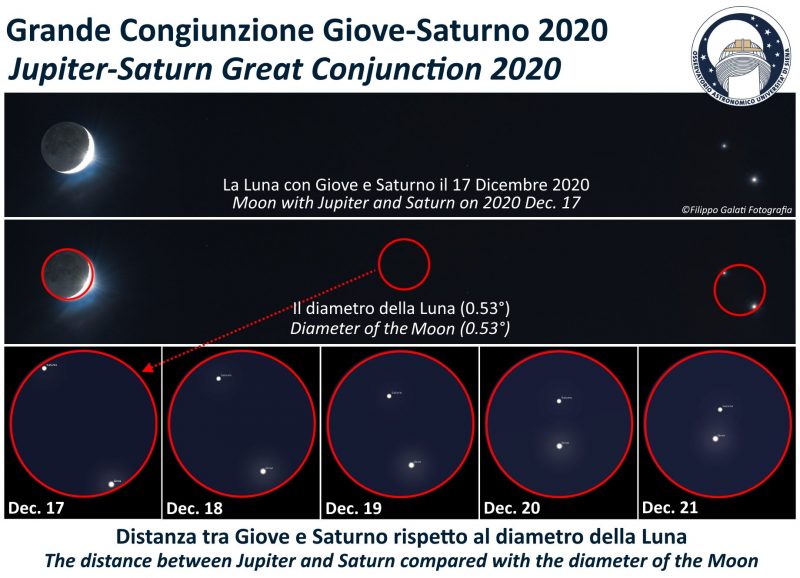All you need to know: 2020’s great conjunction of Jupiter and Saturn

Today’s great conjunction of Jupiter and Saturn will be highly conspicuous in the west just after sunset. The pair will be only 0.1 degree apart at the exact moment of the conjunction. Some say they will look like an elongated star. Will they? Or will they look like a double planet?
Read more: Will Jupiter and Saturn look like one star in 2020?
What if you’re clouded out? How can you watch online? The Virtual Telescope Project in Rome will be showing the Jupiter-Saturn conjunction today, starting at 16:00 UTC; noon on Monday EST; translate UTC to your time. In the telescopic view, you’ll see both planets and some of their moons. Click here to view online.
Astronomers use the word conjunction to describe meetings of planets and other objects on our sky’s dome. They use the term great conjunction to describe meetings of Jupiter and Saturn, which are the two biggest worlds in our solar system. Though the two planets will appear spectacularly close together on the sky’s dome now, Jupiter and Saturn are actually 456 million miles (734 million km) apart. Saturn is nearly twice as far away as Jupiter.
Jupiter-Saturn conjunctions happen every 20 years; the last one was in the year 2000. But these conjunctions aren’t all created equal. The 2020 great conjunction of Jupiter and Saturn will be the closest since 1623 and the closest observable since 1226! 2020’s extra-close Jupiter-Saturn conjunction won’t be matched again until the Jupiter-Saturn conjunction of March 15, 2080.
For all of the reasons above, Jupiter and Saturn are now an appealing and mind-expanding sight. Don’t miss them!
Wow! Your most recent photos of Jupiter and Saturn

At the 2000 great conjunction, 20 years ago, Jupiter and Saturn were near the sun in our sky and difficult to observe. We’re due for a more observable great conjunction. Jupiter and Saturn are up every evening now – not far from the sunset glare – easily visible and exceedingly noticeable as two bright objects near each other. Plus, in the days prior to the conjunction (last week), the young moon appeared appearing in the evening sky, pointing the way to the planets.
Jupiter is brighter than any star. Saturn isn’t as bright as Jupiter, but it’s as bright as the brightest stars and shines with a distinctly golden color. Saturn is just to the east of Jupiter on the sky’s dome. The two are noticeable for their brightness and nearness to each other.

While you’re looking at them, you might notice that – unlike the twinkling stars – Jupiter and Saturn both shine steadily.
In November – during the period when the moon swept past Jupiter and Saturn (about November 16 to November 21) – the two gas giant planets were some 3 degrees apart.
Over the time between November 21 and the day of the conjunction itself, December 21, Jupiter will travel about 6 degrees and Saturn 3 degrees on the sky’s dome. That movement will mean that Jupiter bridges the 3-degree gap between itself and Saturn.
Bingo! Great conjunction! See the image below for Jupiter’s movement over just a few days in December.
The 2021 lunar calendars are here! Order yours before they’re gone.

Saturn is the sixth planet outward from the sun. It’s the farthest and slowest-moving planet that we can easily see with the eye alone. Dazzling Jupiter, the fifth planet outward from the sun, is the second-slowest bright planet, after Saturn. It’s by virtue of their slow motions in front of the constellations of the zodiac that Jupiter and Saturn have the least frequent of bright-planet conjunctions.
Saturn takes nearly 30 years to go around the sun, while Jupiter takes nearly 12 years. Thus, every 20 years, Jupiter catches up to Saturn as viewed from Earth.
From the years 2000 to 2100 inclusive, as viewed from our planet Earth, these Jupiter/Saturn conjunctions (in ecliptic longitude) happen on these dates:
May 28, 2000
December 21, 2020
October 31, 2040
April 7, 2060
March 15, 2080
September 18, 2100

Now, here’s why these great Jupiter/Saturn conjunctions happen every 20 years. Each year, Saturn completes about 12 degrees of its orbit around the sun, whereas Jupiter completes about 30 degrees. Therefore, in one year, Jupiter closes the gap between itself and Saturn by about 18 degrees (30 – 12 = 18 degrees).
In a period of 20 years, then, Jupiter gains 360 degrees on Saturn (18 x 20 = 360 degrees), therefore lapping the ringed planet once every 20 years.
So start watching Jupiter and Saturn now! And mark your calendar for the great conjunction of Jupiter and Saturn on December 21, 2020.

On 21 December Jupiter and Saturn will be at their closest separation in the sky since 1623, at just 0.1° apart! In this new to-scale animation I follow the mid-point between them in the sky #GreatConjunction2020 pic.twitter.com/KXJVBn2KDz
— Dr. James O'Donoghue (@physicsJ) December 19, 2020
Want to see more planets? Check out our latest video project below. It summarizes EarthSky’s monthly guide to the bright planets. Let us know how you like it and how we can make it even better!
Bottom line: Jupiter and Saturn will have their 2020 great conjunction today, which is also the day of the December solstice. These two worlds will be visibly closer in our sky than they’ve been since 1226. At their closest, Jupiter and Saturn will be only 0.1 degree apart. Charts and info in this post.
See more Jupiter-Saturn photos here.
View Jupiter and Saturn online on December 21, via Virtual Telescope.











